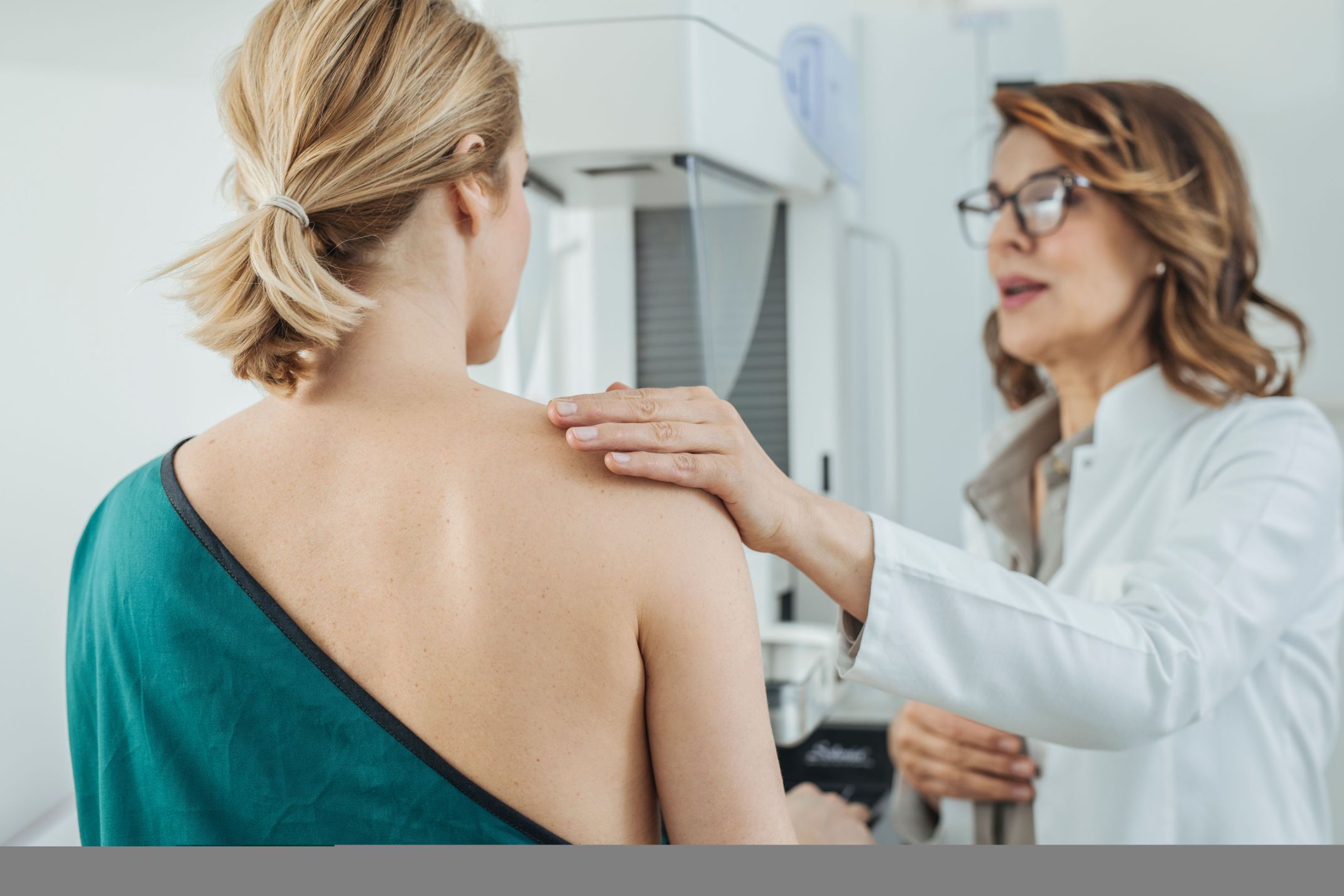-
Patient Resources
-
-
Services
-
-
Service Details
-
Proudly Part of Privia Health

Hotflashes - October 2025
The Role of Genetics in Breast Cancer: Understanding Your Risk

Breast cancer is a complex disease influenced by various factors, including genetics. While most breast cancer cases are not inherited, understanding the role of genetics can help individuals understand their risk and make informed decisions about prevention and early detection.
Inherited Gene Mutations and Breast Cancer Risk
Approximately 5% to 10% of breast cancer cases are hereditary, resulting from gene mutations passed from parent to child. These mutations can significantly increase the risk of developing breast cancer and may also elevate the risk for other cancers. The genes most commonly associated with increased risk include:
- BRCA1 and BRCA2: Mutations in these genes are among the most well-known hereditary causes of breast cancer. Women with a BRCA1 mutation have a 55% to 72% risk, while those with a BRCA2 mutation have a 45% to 69% risk of developing breast cancer by age 70.
- PALB2: Inheriting a PALB2 mutation increases the risk of breast cancer by approximately 35% by age 70.
- CHEK2: Mutations in this gene double the risk of breast cancer compared to the general population.
- TP53: Associated with Li-Fraumeni syndrome, this mutation significantly raises the risk of breast cancer, often at a young age.
- PTEN: Mutations lead to Cowden syndrome, increasing breast cancer risk and the likelihood of developing benign breast tumors.
These mutations may also increase your risk of developing ovarian, pancreatic, or prostate cancers.
Genetic Testing
Genetic testing can identify inherited mutations that increase the risk of breast cancer, so you can understand your risk and be more informed on how to catch breast cancer in the earliest possible stages. The Myriad MyRisk® Hereditary Cancer Test, which we offer here at The Veranda, is one example of genetic testing you can have done to evaluate your cancer risk. This particular test looks at many different genes associated with an increased risk of eight cancers (breast cancer as well endometrial, ovarian, prostate, gastric colorectal, pancreatic, and melanoma cancers). The testing is done through a saliva sample or blood draw, and insurance typically covers 90 percent of testing costs.
When to Consider Genetic Counseling and Testing
Genetic counseling and testing may be appropriate if you have:
- A family history of breast cancer diagnosed before age 50
- Multiple relatives with breast or ovarian cancer
- A known BRCA or other gene mutation in the family
- Personal history of breast cancer at a young age
A genetic counselor can help assess your risk, discuss the benefits and limitations of testing, and interpret results to inform your healthcare decisions.
Lowering Your Risk
If you have inherited mutations, several strategies can help manage your cancer risk:
- Enhanced Screening: Regular mammograms, breast MRIs, and clinical breast exams starting at an earlier age.
- Chemoprevention: Medications like tamoxifen or aromatase inhibitors to reduce the risk of developing breast cancer.
- Prophylactic Surgery: Preventive removal of the breasts (mastectomy) or ovaries (oophorectomy) to significantly lower cancer risk.
These options should be discussed with a healthcare provider to determine the most appropriate approach based on individual risk factors.
https://www.breastcancer.org/risk/risk-factors/genetics
When Periods Become a Problem: Understanding Abnormal Uterine Bleeding

For women in their 40s and 50s, changes in your menstrual cycles are a natural part of life as you transition toward menopause. However, when periods become irregular, heavier, or more prolonged, it may indicate abnormal uterine bleeding, a condition that can be a sign of something else and needs to be addressed with your provider.
What Is Abnormal Uterine Bleeding?
Abnormal uterine bleeding refers to menstrual bleeding that deviates from a woman's typical pattern. This can include:
- Bleeding between periods
- Menstrual cycles shorter than 21 days or longer than 35 days
- Periods lasting longer than 7 days
- Heavy bleeding, such as soaking through a pad or tampon every hour for several
- consecutive hours
- Passing large blood clots
These symptoms may be more common during perimenopause but should not be ignored.
Common Causes in Perimenopausal Women
Several factors can contribute to abnormal uterine bleeding in women approaching menopause, including:
- Hormonal Imbalances: Fluctuating estrogen and progesterone levels can lead to irregular shedding of the uterine lining
- Uterine Fibroids: Benign tumors in the uterine wall can cause heavy bleeding and prolonged periods.
- Polyps: Noncancerous growths in the uterine lining may lead to irregular bleeding.
- Adenomyosis: Endometrial tissue growing into the uterine muscle can result in heavy and painful periods
- Endometrial Hyperplasia: Thickening of the uterine lining can cause heavy or prolonged bleeding and may increase the risk of endometrial cancer.
- Bleeding Disorders: Conditions like von Willebrand disease or platelet dysfunction can lead to excessive bleeding.
When to Talk to Your Doctor
It's important to seek medical advice if you experience:
- Periods that are heavier or longer than usual
- Bleeding between periods
- Fatigue, dizziness, or shortness of breath, which may indicate anemia
- Symptoms that interfere with daily activities
Once you talk to your doctor, they will run tests, like a pelvic exam, pap smear, blood tests, transvaginal ultrasound, and/or endometrial biopsy to determine what could be causing your bleeding.
https://my.clevelandclinic.org/health/diseases/menometrorrhagia-abnormal-uterine-bleeding
Wild Mushroom Soup

Ingredients:
- 12 ounces fresh morels, trimmed, or 1-ounce dried morels plus 12 ounces fresh cremini (baby bella) mushrooms
- 5 cups low-sodium chicken or vegetable broth, or as needed
- 2 tablespoons extra-virgin olive oil, plus more for garnish
- 1 medium carrot, finely chopped
- 1 stalk celery, finely chopped
- 1 small onion, finely chopped
- 1 tablespoon finely chopped garlic
- ¼ cup Marsala (see Tip)
- 1 cup diced peeled potato
- 1 ½ teaspoons finely chopped fresh thyme
- 1 ½ teaspoons kosher salt
- ⅛ teaspoon crushed red pepper, or to taste
- Freshly ground pepper to taste
- ¼ cup coarsely chopped flat-leaf parsley
Directions:
- If using fresh morels, cut in half and briefly swish in a large bowl of tepid water. Drain and repeat to remove all the dirt. Gently but thoroughly pat dry, then coarsely chop. (If using dried morels, soak in 2 cups warm water for 30 minutes. Strain in a cheesecloth-lined sieve and reserve the soaking liquid. Add enough broth to the soaking liquid to equal 5 cups. Coarsely chop the morels and creminis.)
- Heat oil in a large pot over medium heat. Add carrot, celery and onion; cover and cook, stirring occasionally, until the vegetables are tender, 8 to 10 minutes. Add garlic and cook, stirring frequently, for 30 seconds. Add Marsala and cook for 1 minute more.
- Add the broth, the fresh mushrooms (and dried, if using), potato, thyme, salt and crushed red pepper. Bring to a boil. Reduce heat and simmer, uncovered, until the potato is tender, 15 to 20 minutes.
- Puree the soup with an immersion blender or in a regular blender or food processor. Stir in pepper. Serve the soup garnished with parsley and a drizzle of oil, if desired.
https://www.eatingwell.com/recipe/251177/wild-mushroom-soup/
